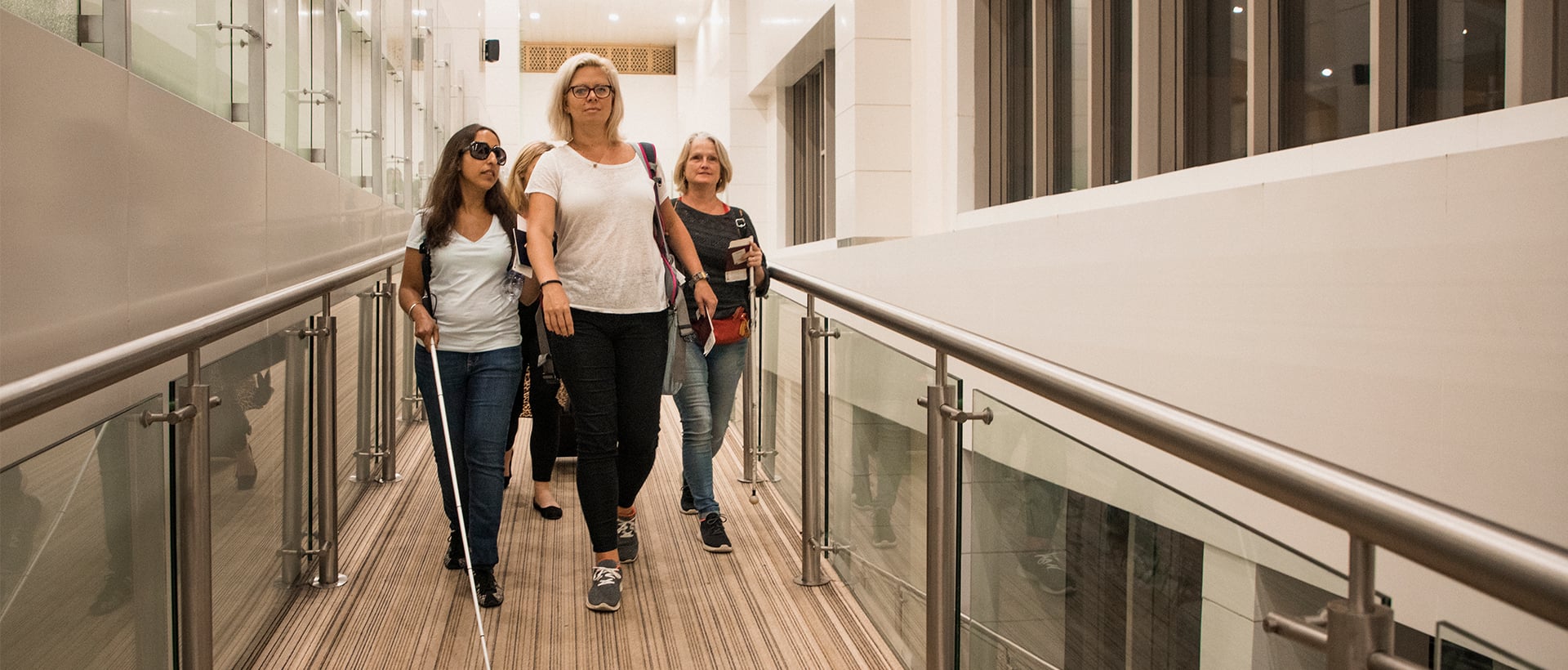Air travel can be stressful for just about anyone – particularly first-time fliers. While traveling with a disability does present additional challenges, that doesn’t stop many blind and visually impaired people from pursuing their dreams of traveling the world for pleasure or business.
Like anything else in life, air travel gets easier the more often you do it. With that in mind, we asked several avid travelers – all of whom are blind or visually impaired – to let us in on their personal travel hacks. Use a few of these expert travel tips for the blind on your next trip to help guarantee a smoother, less stressful journey!
 Before You Go
Before You Go
Contact the airline
A little advanced preparation can save you a lot of travel headaches and delays. While airport personnel should always accommodate requests for assistance at the airport itself, making arrangements in advance can help save time.
Before traveling, Marcia Wick, member of Guide Dogs for the Blind Paws Around the World (GDB PAW), advises contacting the airlines disability support desk. “They usually have a dedicated phone number if you need to request an escort to the gate,” she explains. She also recommends ensuring that any friend or family member traveling with you have the same type of gate pass as you. “If your boarding pass allows you to go through the fast track line, your escort’s gate pass must allow the same or you will get separated,” she advises.
Get acquainted with airports
Many blind and visually impaired travelers say they take advantage of sites like Wikipedia and Yelp in order to learn about the airports they’ll be visiting. Knowing details like the number of gates and the location of your preferred restaurants or kiosks can help make navigating the airport easier, particularly if you wish to navigate the airport independently.
Plan ahead for your pup
As you’re likely aware, traveling with a guide dog requires a bit of additional preparation. In order to avoid any potential hiccups, you may want to contact your airline in advance to notify them that you’ll be traveling with a service dog. If this is your first time flying with your pup, then it’s a good idea to visit the TSA’s official website to learn what to expect from the airport security screening process. Anything Pawsable has also has wonderful, in-depth guide to service dog travel that details every step of the process, from planning to boarding the plane and beyond.
If you’re traveling outside of the Continental United States with a service animal, you’ll need to do a bit of extra planning in advance. Rules regarding animals vary by country, and some countries do require all incoming animals to be quarantined for a period of time. Both the U.S. Department of State and Assistance Dogs Internationalcan help you learn more about the laws in your destination country and plan ahead.
Packing For Your Trip
Get organized
Mary Kozy, member of GDB PAW, suggests using a backpack instead of a carry-on suitcase, explaining, “It is easier to have hands free when traveling with a guide dog.”
Another tip? Have important items like your ticket and passport within reach. “I always wear slacks with pockets so I can keep the important paperwork handy,” explains Mary. She also advises having a list of important phone numbers handy in Braille or audio format.

Plan for emergencies
While losing your luggage is stressful enough as is, it can be particularly disastrous when your suitcase contains your dog’s food. Penny Zibula of Six Legs Will Travelalways plans ahead for such emergencies.
“In my backpack, I always have a few Ziploc bags with a portion of food, a few treats, a collapsable bowl, and a roll of extra busy bags. That way, if the airline loses my checked luggage, [my service dog] Otto will be okay,” she says.
To make your entire journey easier from start to finish, Mary suggests bringing the following items:
- Small Bills: Mary suggests putting a handful of small bills in your pocket so you can easily tip those that assist you.
- Snacks: “You never know where you will end up or how long it will take, so bring along trail mix, nuts, pretzels, etc.”
- Ice Chips: This is a much easier way to keep your dog hydrated. “Ice chips are an easy substitute for water,” she explains, adding, “they limit your dog’s water intake so your dog can go longer without relieving.
Make your luggage easy to identify
Finding and retrieving checked bags can be a hassle for anyone – even moreso for travelers who are blind or visually impaired. Since so many suitcases look alike, it’s a good idea to tie a colorful ribbon to your suitcase in order to make yours easily identifiable to anyone who may be assisting you. In addition, the AFB suggests using an audible locator to make the process of identifying your luggage even easier. Others have suggested using tracking devices on important items like your passport or wallet while traveling.
Read More
Looking for a bit of travel inspiration? Check out these articles and blogs focused on traveling with blindness.


